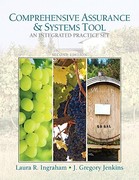Answered step by step
Verified Expert Solution
Question
1 Approved Answer
1. (TCO C) Redstone Company spent $190,000 developing a new process, $45,000 in legal fees to obtain a patent, and $91,000 to market the process
1. (TCO C) Redstone Company spent $190,000 developing a new process, $45,000 in legal fees to obtain a patent, and $91,000 to market the process that was patented. How should these costs be accounted for in the year they are incurred? 2. (TCO D) Total payroll of Watson Co. was $920,000, of which $160,000 represented amounts paid in excess of $100,000 to certain employees. The amount paid to employees in excess of $7,000 was $720,000. Income taxes withheld were $225,000. The state unemployment tax is 1.2%, the federal unemployment tax is .8%, and the FICA tax is 7.65% on an employees wages to $100,000 and 1.45% in excess of $100,000. (a) Prepare the journal entry for the wages and salaries paid. (b) Prepare the entry to record the employer payroll taxes. 3. (TCO D) Hurst, Incorporated sold its 8% bonds with a maturity value of $3,000,000 on August 1, 2009 for $2,946,000. At the time of the sale, the bonds had 5 years until they reached maturity. Interest on the bonds is payable semiannually on August 1 and February 1. The bonds are callable at 104 at any time after August 1, 2011. By October 1, 2011, the market rate of interest has declined and the market price of Hurst's bonds has risen to a price of 101. The firm decides to refund the bonds by selling a new 6% bond issue to mature in 5 years. Hurst begins to reacquire its 8% bonds in the market and is able to purchase $500,000 worth at 101. The remainder of the outstanding bonds is reacquired by exercising the bonds' call feature. In the final analysis, how much was the gain or loss experienced by Hurst in reacquiring its 8% bonds? (Assume the firm used straight-line amortization.) Show calculations. 4. (TCO E) Parker Corporation has issued 2,000 shares of common stock and 400 shares of preferred stock for a lump sum of $72,000 cash. Instructions: (a) Give the entry for the issuance, assuming the par value of the common was $5 and the market value $30, and the par value of the preferred was $40 and the market value $50. (Each valuation is on a per-share basis and there are ready markets for each stock.) (b) Give the entry for the issuance assuming the same facts as (a) above except the preferred stock has no ready market value, and the common stock has a market value of $25 per share. 5. (TCO F) Describe the journal entry for a stock dividend on common stock (which has a par value) 6. (TCO A) At December 31, 2010, Kifer Company had 500,000 shares of common stock outstanding. On October 1, 2011, an additional 100,000 shares of common stock were issued. In addition, Kifer had $10,000,000 of 6% convertible bonds outstanding at December 31, 2010, which are convertible into 225,000 shares of common stock. No bonds were converted into common stock in 2011. The net income for the year ended December 31, 2011, was $3,000,000. Assuming the income tax rate was 30%, what would be the diluted earnings per share for the year ended December 31, 2011 7. (TCO B) Agee Corp. acquired a 25% interest in Trent Co. on January 1, 2010, for $500,000. At that time, Trent had 1,000,000 shares of its $1 par common stock issued and outstanding. During 2010, Trent paid cash dividends of $160,000 and thereafter declared and issued a 5% common stock dividend when the market value was $2 per share. Trent's net income for 2010 was $360,000. What is the balance in Agees investment account at the end of 2010
Step by Step Solution
There are 3 Steps involved in it
Step: 1

Get Instant Access to Expert-Tailored Solutions
See step-by-step solutions with expert insights and AI powered tools for academic success
Step: 2

Step: 3

Ace Your Homework with AI
Get the answers you need in no time with our AI-driven, step-by-step assistance
Get Started


